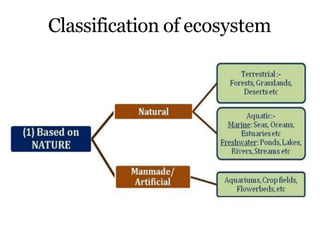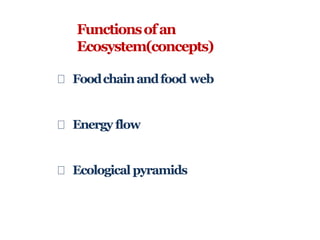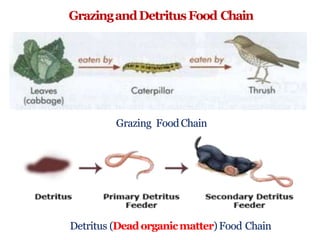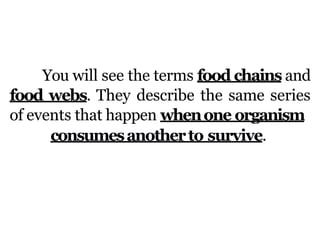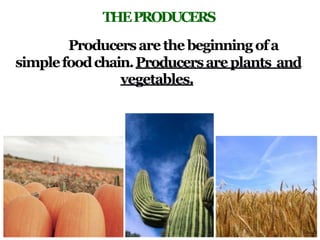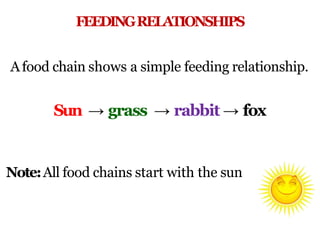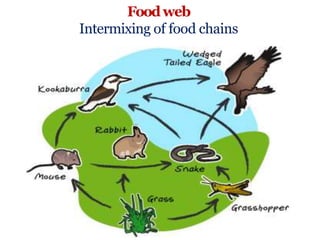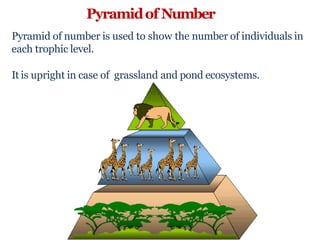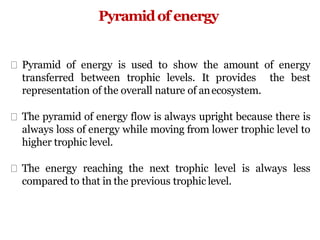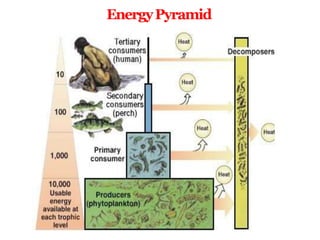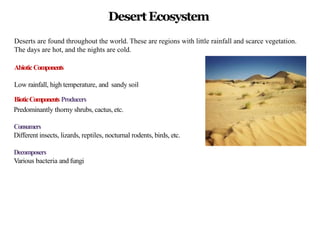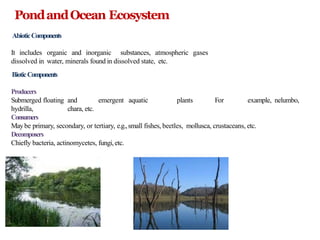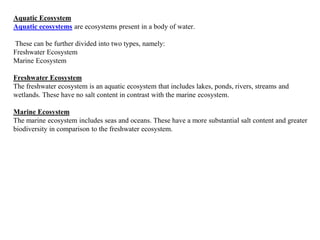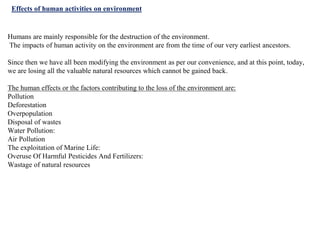unit -2 final.pptx
- 1. Definition Environment can be defined as a sum total of all the living and non-living elements and their effects that influence human life. While all living or biotic elements are animals, plants, forests, fisheries, and birds, non- living or abiotic elements include water, land, sunlight, rocks, and air. The Environment can be divided into four segments: Atmosphere Hydrosphere Lithosphere Biosphere Ecology is the study of organisms and how they interact with the environment around them. Ecosystem : The simplest definition of an ecosystem is that it is a community or group of living organisms that live in and interact with each other in a specific environment. Ecosystems can be small-scale, covering a small area such as a pond or large-scale covering a large area such as a tropical rainforest. The world is divided up into ten major ecosystems. An ecosystem is a community of living organisms in conjunction with the nonliving components of their environment things like air, water and mineral soil interacting as a system.
- 2. • All the populations in a specific area at a given time a community includes populations of organisms of different species. • These biotic and abiotic components are regarded as linked together through nutrient cycles and energy flows. • As ecosystems are defined by the network of interactions among organisms, and between organisms and their environment, they can be of any size but usually encompass specific, limited spaces although some scientists say that the entire planet is an ecosystem. • An ecosystem can be destroyed by a stranger. • The stranger could be the rise in temperature or rise in sea level or climate change. • The stranger can affect the natural balance and can harm or destroy the ecosystem. • It is a bit unfortunate but ecosystems have been destroyed and vanished by man-made activities like deforestation, urbanization and natural activities like floods, storms, fires or volcanic eruptions.
- 3. Structureofan Ecosystem Living(Biotic) Components Producers Consumers Decomposers Non-living(Abiotic)Components Physical factors Chemical factors Limiting factors
- 4. BioticComponentsof Ecosystems Producers(or autotrophs) Green plants and some bacteria which manufacture their ownfood. Consumers(or heterotrophs) Animals which obtain their food from producers Primary consumers Secondary consumers Tertiary consumers Decomposers Bacteria and fungi that decompose dead organic matter and convert it into simpler parts
- 5. AbioticComponentsofan Ecosystem PhysicalFactors Rainfall Sunlight Humidity Temperature Nature of soil Water currents ChemicalFactors Salinity of Water Nutrients present in soil Oxygen dissolved in water Percentage of water and air insoil Food, water, shelter and space are Limiting Factors limiting factors for the growth of population of human and animals.
- 7. Kindsof Ecosystems Natural Ecosystems Man-made Ecosystems Terrestrial Ecosystems Aquatic Ecosystems Fresh water Ecosystems Marine Ecosystems Lentic Ecosystems (Static water) Lotic Ecosystems (Running water)
- 8. Foodchainandfood web Energy flow Ecological pyramids Functionsofan Ecosystem(concepts)
- 9. FoodChain The transfer of food energy from the source (plants) through a series of organisms by repeated eating and being eaten up is referred to as food chain.
- 10. FoodWeb The interlocking pattern formed by several food chains that are linked together is called a food web.
- 11. FoodChain A series of organism by repeated eating and being eaten up is referred as food chain. Types: Grazingfoodchain-a commonchain Detritus food chain- chain derived by the organic wastes and dead matter from grazingfood chains Theprocess ofeatingandbeing eaten
- 12. GrazingandDetritusFood Chain Detritus (Deadorganicmatter)Food Chain Grazing Food Chain
- 13. You will see the terms food chains and food webs. They describe the same series of events that happen whenone organism consumesanotherto survive.
- 15. THEPRODUCERS All energy comes from the Sun and plants are the ones who make food with that energy. They use the processof photosynthesis. Plants nutrients also make for other organismsto eat.
- 16. Consumersarethe nextlink inafood chain.Therearethreelevels of consumers.
- 17. FEEDINGRELATIONSHIPS Afood chain shows a simple feeding relationship. Sun → grass → rabbit → fox Note:All food chains start with the sun
- 18. All food chains start with ENERGY from the sun
- 19. Foodweb Intermixing of food chains
- 20. EnergyFlowin Ecosystems First Lawof Thermodynamics: energy can neither be created nor destroyed but only is transformed from one form toanother. Second Law of Thermodynamics: the second law of thermodynamics states that no energy transformations are 100% efficient. 10 PercentRuleof Energy As a rule of thumb, 90 percent of the energy involved is degraded at each trophic transfer and only 10 percent of the energy is conserved inthe organism's tissue.
- 23. Ecological Pyramid The graphical representations of different trophic levels in an ecosystem where producers occupy the base and the top consumer occupy the apex of the pyramid, is known as ecological pyramid .
- 24. Pyramidof Number Pyramid of number is used to show the number of individuals in each trophic level. It is upright in case of grassland and pond ecosystems.
- 27. Pyramidof energy Pyramid of energy is used to show the amount of energy transferred between trophic levels. It provides the best representation of the overall nature of anecosystem. The pyramid of energy flow is always upright because there is always loss of energy while moving from lower trophic level to higher trophic level. The energy reaching the next trophic level is always less compared to that in the previous trophic level.
- 28. EnergyPyramid is
- 30. Studyofsomecommon ecosystems Terrestrial ecosystem Grasslandecosystem Desertecosystem Forestecosystem Aquatic ecosystem Pondecosystem Oceanecosystem
- 31. Forest Ecosystem A forest ecosystem consists of several plants, particularly trees, animals and microorganisms that live in coordination with the abiotic factors of the environment. Forests help in maintaining the temperature of the earth and are the major carbon sink. AbioticComponents Inorganic and organic substances found in the soil, climatic factors, e.g., temperature, humidity, rainfall, and light. BioticComponents Producers Different kinds of trees depending upon theclimate Consumers Different kinds of primary, secondary, and tertiary consumers, e.g.,deer, elephant, moles, snakes, lizards, lion, and tiger Decomposers These are various kinds of bacteria andfungi
- 32. Grasslandecosystem In a grassland ecosystem, the vegetation is dominated by grasses and herbs. Temperate grasslands and tropical or savanna grasslands are examples of grassland ecosystems. All grasslands in the world are categorize into the following two types: Tropical grasslands- closets to equator and are hot throughout the year. Temperate grasslands- farther from the equator and have both hot summers and harsh winters.
- 33. GrasslandEcosystem Abiotic Components climatic components, temperature, rainfall, light, etc. BioticComponents Producers Mainly grasses with a few scatteredtrees Consumers Deer, rabbit, giraffe, etc., are herbivores, while wolf, leopard, etc., are carnivores Decomposers Mainly bacteria and fungi
- 34. DesertEcosystem Deserts are found throughout the world. These are regions with little rainfall and scarce vegetation. The days are hot, and the nights are cold. AbioticComponents Low rainfall, high temperature, and sandy soil BioticComponents Producers Predominantly thorny shrubs, cactus, etc. Consumers Different insects, lizards, reptiles, nocturnal rodents, birds, etc. Decomposers Various bacteria and fungi
- 35. PondandOcean Ecosystem AbioticComponents It includes organic and inorganic substances, atmospheric gases dissolved in water, minerals found in dissolved state, etc. BioticComponents Producers Submerged floating and emergent aquatic plants For example, nelumbo, hydrilla, chara, etc. Consumers Maybe primary, secondary, or tertiary, e.g.,small fishes, beetles, mollusca, crustaceans, etc. Decomposers Chiefly bacteria, actinomycetes, fungi,etc.
- 36. Aquatic Ecosystem Aquatic ecosystems are ecosystems present in a body of water. These can be further divided into two types, namely: Freshwater Ecosystem Marine Ecosystem Freshwater Ecosystem The freshwater ecosystem is an aquatic ecosystem that includes lakes, ponds, rivers, streams and wetlands. These have no salt content in contrast with the marine ecosystem. Marine Ecosystem The marine ecosystem includes seas and oceans. These have a more substantial salt content and greater biodiversity in comparison to the freshwater ecosystem.
- 37. Effects of human activities on environment Humans are mainly responsible for the destruction of the environment. The impacts of human activity on the environment are from the time of our very earliest ancestors. Since then we have all been modifying the environment as per our convenience, and at this point, today, we are losing all the valuable natural resources which cannot be gained back. The human effects or the factors contributing to the loss of the environment are: Pollution Deforestation Overpopulation Disposal of wastes Water Pollution: Air Pollution The exploitation of Marine Life: Overuse Of Harmful Pesticides And Fertilizers: Wastage of natural resources





